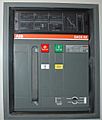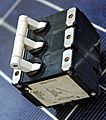Circuit breaker facts for kids
A circuit breaker is a very important safety device in your home or school. It's designed to automatically turn off the electrical power if too much electricity tries to flow through a circuit. This usually happens if you plug in too many devices at once, or if there's a problem called a short circuit.
Circuit breakers are typically found in a main electrical box, often called a panelboard. Think of them as smart switches that protect your electrical system. Inside a common circuit breaker, there's usually an electromagnetic coil. If a sudden surge of too much electricity flows, this coil quickly pulls a switch, instantly cutting off the power. This protects against immediate dangers like short circuits.
There's also a special metal strip inside called a bimetal strip. If too much electricity flows for a longer time, this strip gets hot and bends. When it bends enough, it also pulls the switch, turning off the power. This protects against things like too many devices being plugged in for a long time.
Some newer circuit breakers use electronic sensors to detect too much current and shut off the power. A circuit breaker does the same job as an old-fashioned fuse. But unlike a fuse, which you have to replace after it blows, you can usually just reset a circuit breaker by flipping its switch back on. However, in very serious cases, like a huge short circuit or a lightning strike, a circuit breaker might get damaged and need to be replaced.
Contents
How Circuit Breakers Work
Circuit breakers are like guardians of your electrical system. They prevent wires from overheating and causing fires. When a circuit breaker "trips" (turns off), it means it detected a problem and protected you.
Inside a Circuit Breaker
Most circuit breakers use two main ways to detect problems:
- Electromagnet: This part reacts very quickly to sudden, large increases in electricity, like a short circuit. When the current gets too high, the electromagnet becomes strong enough to pull a lever and trip the breaker.
- Bimetallic Strip: This strip is made of two different metals joined together. When too much electricity flows for a longer time, the strip heats up. Because the two metals expand at different rates, the strip bends. This bending then pushes a lever, tripping the breaker. This protects against smaller, but still dangerous, overloads.
Types of Circuit Breakers
Circuit breakers come in different types, depending on how much electricity they need to handle and how they put out the electrical spark (arc) when they trip.
By Voltage Level
- Low-voltage circuit breakers: These are the ones you usually find in homes and small buildings. They handle electricity up to about 1,000 volts.
- Medium-voltage circuit breakers: Used in larger buildings, factories, and power distribution systems. They handle electricity from 1,000 volts up to about 72,500 volts.
- High-voltage circuit breakers: These are very large and are used in power transmission networks, like those that carry electricity across long distances from power plants. They handle extremely high voltages, often hundreds of thousands of volts.
By Arc Suppression Medium
When a circuit breaker opens, it creates an electrical spark, or "arc." Different materials are used to safely put out this arc.
- Air circuit breaker: These use air to cool and put out the arc. They are common for low-voltage systems.
- Oil circuit breaker: These use oil to cool and insulate the contacts, helping to put out the arc. They were once common for medium and high voltages.
- Sulfur hexafluoride (SF6) circuit breaker: These use SF6 gas, which is very good at insulating and putting out arcs. They are often used for high-voltage systems.
- Vacuum circuit breaker: These have their contacts in a sealed vacuum. Since there's no air, the arc cannot form easily, making them very efficient for medium-voltage systems.
Other pages
Images for kids
-
A residual current circuit breaker with extra protection against too much current.
See also
 In Spanish: Disyuntor para niños
In Spanish: Disyuntor para niños











